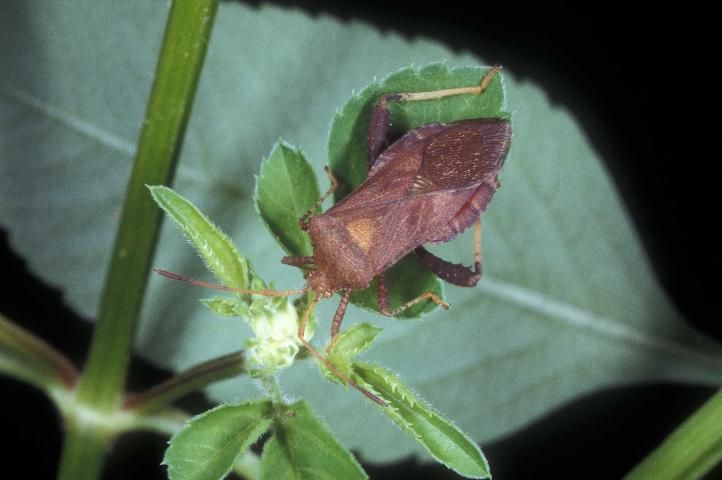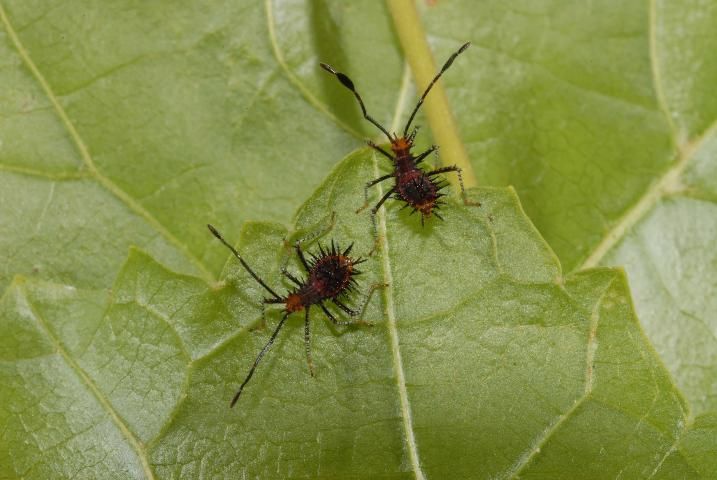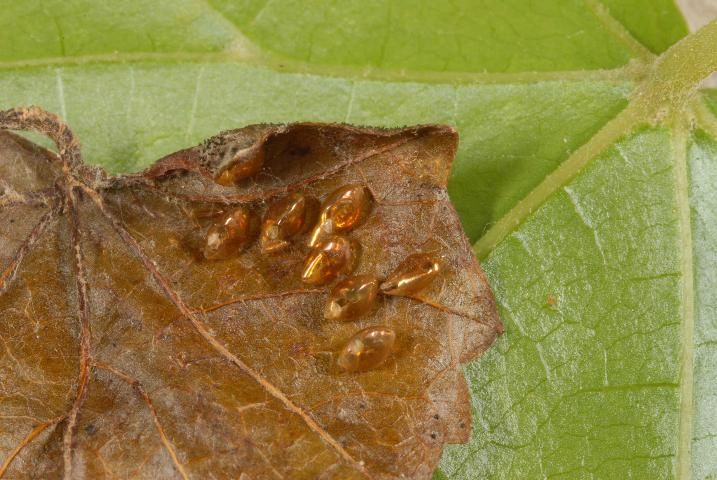The Featured Creatures collection provides in-depth profiles of insects, nematodes, arachnids and other organisms relevant to Florida. These profiles are intended for the use of interested laypersons with some knowledge of biology as well as academic audiences.
Introduction
The coreid bug, Euthochtha galeator (Fabricius), is common throughout the eastern United States west to the Great Plains (Slater and Baranowski 1978). The Florida State Collection of Arthropods (FSCA) contains numerous specimens and reports ranging from the northwestern tip of Florida to Key West. It feeds on a variety of wild and cultivated plants, occasionally becoming a pest primarily in dooryard situations where it can injure roses, citrus, and other fruits and ornamentals.

Credit: Lyle J. Buss, UF/IFAS
Description and Identification
Eggs
Yonke and Medler (1969b) reported the egg as 1.84 x 1.20 x 1.23 mm (~1/16 x 1/16 x 1/16 in) (mean value), roughly triangular in cross-section, and flattened on the underside. Eggs sometimes are whitish but usually are a bright gold color turning to bright red just before eclosion. Eggs usually are laid in small patches on either surface of a leaf but sometimes are laid in a row on a linear host such as a grass blade. Yonke and Medler (1969a) reported a range of 2 to 32 eggs per batch, the mean number being 16 eggs per batch. The number of batches per female ranged from 3 to 19, with the mean number being 8.2. The greatest number of eggs deposited by a single female was 259.
Nymphs
Early instar nymphs tend to be purplish or reddish brown with orange heads. Older nymphs are variable but tend to be orange to yellowish brown, with the head mottled. All five instars are characterized by spines, mottling, and a dilated 3rd antennal segment. This is the only coreid nymph in eastern US having the 3rd antennal segment (only) dilated. Nymphs of the coreids Chariesterus antennator (Fabricius) and Chondrocera latifornis LaPorte have both the 2nd and 3rd segments dilated; this expansion may not be as pronounced in the 2nd segment of early instar nymphs. The dilation of the antennae continues in adults as a partially expanded 3rd segment in Chariesterus and dilated 2nd and 3rd segments in Chondrocera; however, no segments of the adult of Euthochtha are dilated, all having a similar filiform shape, with the terminal segment usually being darker.

Credit: Lyle J. Buss, UF/IFAS
Adults
Length 13 to 17 mm (1/2 to 2/3 in); width 5 to 7.5 mm (3/16 to 1/3 in). Color dull brown, membrane darker; connexivum spotted in some, nearly concolorous in other specimens. Pronotum with anterior part of lateral margins finely and irregularly toothed. Humeri prominent but not spined. Hind femora swollen, especially in males, and with spines underneath, tubercles above.

Credit: Lyle J. Buss, UF/IFAS
Special Character
Males have a white- or cream-colored spur or flap on the posterodorsal corner of the side of the thorax (metepimeron) next to the abdomen. This easily is spotted in the field. No other known insect in eastern US has such a projection. The females lack this flap but do have a whitish callus in the metapleural area. For a more complete description of the adult see Blatchley (1926) or Deay (1928). Consult Blatchley (1926), Schaeffer (1965), and Torre-Bueno (1941) for keys to the pertinent subfamilies and tribes of Coreidae.
Life History
Yonke and Medler (1969a) reported that eggs took about 13 days to incubate, nymphal development was approximately 54 days, and adults were long lived; two adults collected from the field in June lived 204 and 212 days. Young nymphs frequently were observed in feeding aggregations. Adults were reported to feign death. Whenever disturbed they would either drop from the plant and remain motionless, or fly away quickly. Froeschner (1942) reported E. galeator as common in Missouri in low, moist, weedy sections of woods, but also in weedy fields.
Mating was observed in June. Adults were collected all year; hibernating forms were collected under bark and among fallen leaves and other debris. Nymphs were collected in June and early July. Hoffman (1975) reported two peaks in the collecting of adults in Virginia. The first peak (coming out of hibernation) was from late April to mid-June, the second from late August through September (the ones destined for hibernation). The FSCA has more records of adults in March than any other month, but reports were fairly evenly divided throughout the warmer months. Blatchley (1926) reported Euthochtha galeator on the foliage of shrubs and trees along the slopes of hills and borders of thickets and roadsides in Indiana. At Dunedin, Florida he reported it in spring most frequently on sedges and weeds along the margins of lakes and ponds.
Economic Importance
Hubbard (1885) reported that Euthochtha galeator "was a very common and often a very destructive insect" on oranges (citrus). Ebeling (1959) reported Euthochtha galeator as having caused defoliation of potted plants of lychee, Litchi chinensis Sonn. Griffiths and Thompson (1957) reported that in Florida Euthochtha galeator fed on tender succulent twigs of citrus causing them to wilt and die. This type of damage was noted on as high as 25% of the trees in a small block of citrus; affected twig tips would turn brown and might die back as much as 6 inches. Based on records in FSCA, Euthochtha galeator is a persistent pest of dooryard roses. Undisturbed nymphs and adults tend to feed in one spot for many hours; the longer the feeding the more pronounced the resulting injury. This injury seems to be caused by the injection of toxic substances, probably enzymes, into the plant tissue.

Credit: Lyle J. Buss, UF/IFAS
Survey and Detection
Look for a patch of golden-colored eggs on either surface of a leaf. Look for spiny nymphs, having dilated 3rd antennal segment, on succulent stem near cluster of terminal young leaves. Look for brownish, stout-bodied adults (16 mm (2/3 in) long, 6 mm (1/4 in) wide) on young stems, foliage or buds. Most likely cultivated host plants are roses and to a lesser extent fruits, such as citrus and lychee. Wild hosts include composites, wild plums, polygala, grasses, sedges, nettles, sumac, young growth of hickory and oak, mint, etc.
Look for host damage caused by feeding of Euthochtha galeator. Blossoms become malformed; young leaves become droopy, withered, and brownish.
It should be possible to collect Euthochtha galeator in any Florida county.
Management
Chemical
If chemical control is used, be especially careful to follow directions on label if fruits or other edibles are sprayed. Commercial plantings undergoing regular treatment for other insects seldom have a problem with this bug.
For more information see Florida Citrus Production Guide for Plant Bugs (https://edis.ifas.ufl.edu/CG005)
Biological
Yonke and Medler (1969a) reported in Wisconsin two hymenopterous egg parasites [Anastatus pearsalli Ashmead and Ooencyrtus anasae (Ashmead)] and a tachinid fly [Trichopoda pennipes (Fabricius)] that attacks adults. The latter two species are known to be in Florida.
Selected References
Blatchley WS. 1926. Heteroptera or True Bugs of Eastern North America, with Especial Reference to the Faunas of Indiana and Florida. Indianapolis, IN: Nature Publishing Company.
Deay HO. 1928. The Coreidae of Kansas. University of Kansas Science Bulletin 18: 371–415.
Ebeling W. 1959. Subtropical fruit pests. Los Angeles, CA: University of California, Division of Agricultural Sciences.
Froeschner RC. 1942. Contributions to a synopsis of the Hemiptera of Missouri, Pt. II. American Midland Naturalist 27: 591–609.
Griffiths JT, Thompson WL. 1957. Insects and mites found on Florida citrus. University of Florida Agricultural Experiment Station Bulletin 591: 1–86.
Hoffman RL. 1975. The insects of Virginia: No. 9. Squash, broad-headed, and scentless plant bugs of Virginia (Hemiptera: Coreoidea: Coreidae, Alydidae, Rhopalidae). Blacksburg, VA: Research Division Bulletin 105, Virginia Polytechnic Institute & State University.
Hubbard HG. 1885. Insects Affecting the Orange. Washington, DC: U.S. Department of Agriculture, Division of Entomology, 48th Congress, 2nd Session, House of Representatives, Miscellaneous Document No. 40, U.S. Government Printing Office.
Schaeffer CW. 1965. The morphology and higher classification of the Coreoidea (Hemiptera-Heteroptera). Part III. The families Rhopalidae, Alydidae, and Coreidae. Miscellaneous. Publications of the Entomological Society of America: 1–76.
Slater JA, Baranowski RM. 1978. How to know the true bugs (Hemiptera-Heteroptera). Dubuque, IA: The Picture Key Nature Series, W.C. Brown Co.
Torre-Bueno JR. de la. 1941. A synopsis of the Hemiptera-Heteroptera of America north of Mexico. Part II. Families Coreidae, Alydidae, Corizidae, Neididae, Pyrrhocoridae and Thaumastotheriidae. Ent. Amer. 21: 41–122.
Yonke TR, Medler JT. 1969(a). Biology of the Coreidae in Wisconsin. Wisconsin Academy of Scientific Arts & Letters 57: 163–188.
Yonke TR, Medler JT. 1969(b). Description of immature stages of Coreidae. 1. Euthochtha galeator. Annals of the Entomological Society of America 62: 469–473.